A Private Tour today in North Norfolk. The weather was mostly fine and bright, apart from one dark cloud which passed overhead very quickly early afternoon and produced just a few spots of light drizzle, barely enough to notice. But it was very windy all day, which made life difficult at times.
As we drove west along the coast towards Titchwell, our first Marsh Harrier of the day was quartering the fields by the road. A Red Kite hung in the air over a small copse of trees. The raptors were up enjoying the wind.
When we got to Titchwell, a quick walk round the car park before it got too busy produced singing Blackcap and Chiffchaff in the trees, plus a Greenfinch wheezing in the bushes and a couple of Chaffinches and Goldfinches too. A pair of Red-legged Partridges in the field beyond the gates at the far end ran off as we approached. There were just a few tits and finches on the feeders by the Visitor Centre, so we headed straight out onto the reserve.
It was exposed to the wind once we got out onto the main path. We could hear a couple of Reed Buntings and a Reed Warbler singing, but they were keeping well tucked down today. There seemed little chance of finding a Bearded Tit – the one thing they don’t seem to like is wind. We did see a Cuckoo though, which flew across the reedbed and away over Island Hide and out across the saltmarsh.
The reedbed pool held a couple of drake Red-crested Pochard, but they were right out towards the back today. We headed towards the Freshmarsh and the shelter of the hides. As we approached Island Hide, a Common Redshank was fluttering up over the edge of the reeds calling, and was joined by a second. Then we realised why – down on the mud below them were two half grown juveniles.
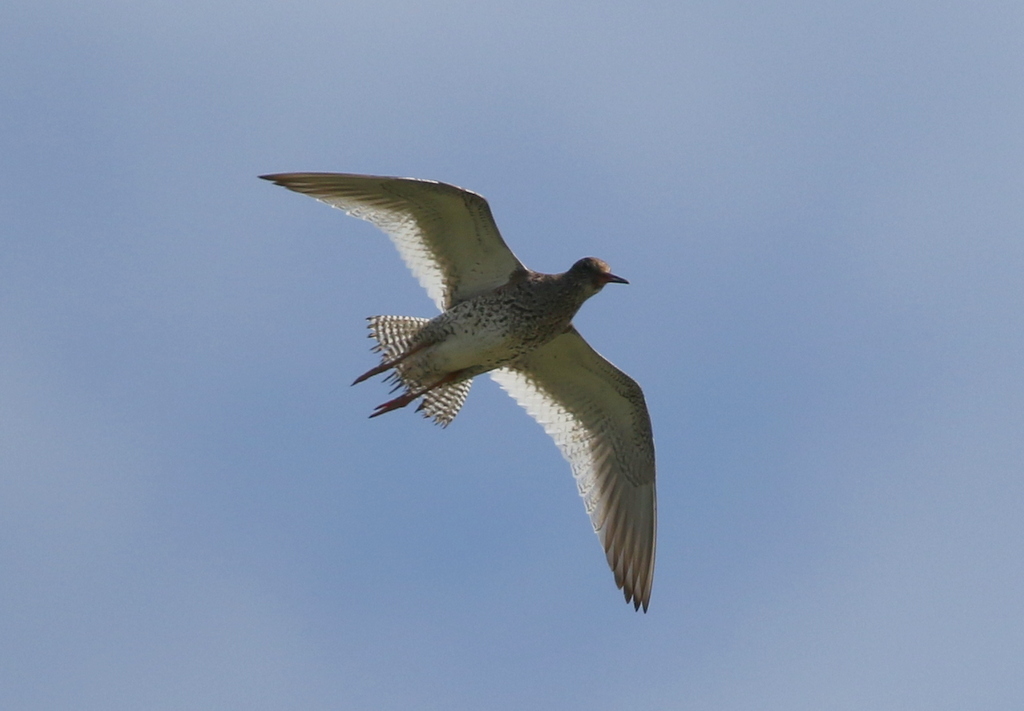
There were a few other waders out on the Freshmarsh, although it was clear that numbers were down this morning, probably due to the wind. About thirty Black-tailed Godwits were mostly asleep on the nearest island, and in with them we could see a couple of Bar-tailed Godwits too. Even though they were head on to us, we could see their more obvious pale supercilia and slightly upturned bills.
There were only about a dozen Dunlin, and they were all huddled around the rocks along the edge of the tern island. There was no sign of the Curlew Sandpiper though, so presumably it had flown off with some of the other Dunlin. With the strong wind having blown the water away from Island Hide, the few Avocets which were not sleeping were feeding out along the edge of the reeds.
There are lots of gulls out on the Freshmarsh at the moment, with Avocet Island having been taken over by them. In amongst the scattered Black-headed Gulls feeding in the water around the islands, we picked out several Little Gulls. The more we looked, the more we found – there were at least 10 here, all young, first summer birds, with extensive black markings in the wings and lacking the full black summer hood of an adult.
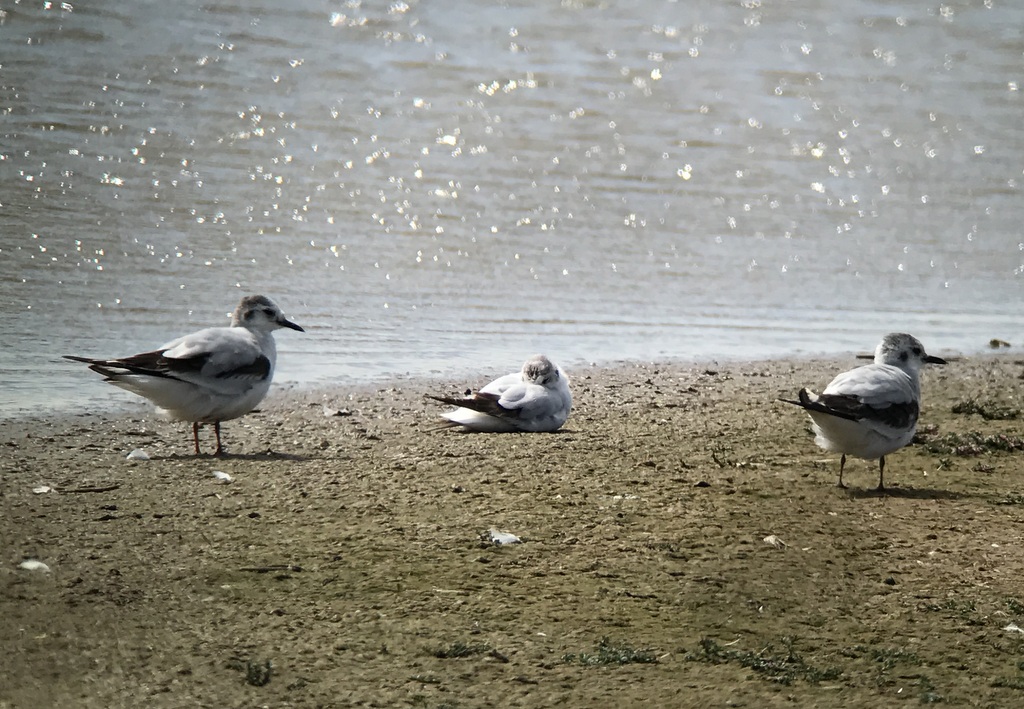
A pair of Common Terns were settled down on Tern Island where we could get them in the scope, but a Little Tern flew off past the hide and out towards Thornham saltmarsh without stopping. We headed round to Parrinder Hide, and were rewarded with better views of a Little Tern which flew in and helpfully landed on one of the islands.
A couple of the Little Gulls were feeding right in front of the hide, dipping down to pick insects from the surface of the water or picking round the edges of the islands. We had a great view of the inverted ‘w’ pattern on their wings.
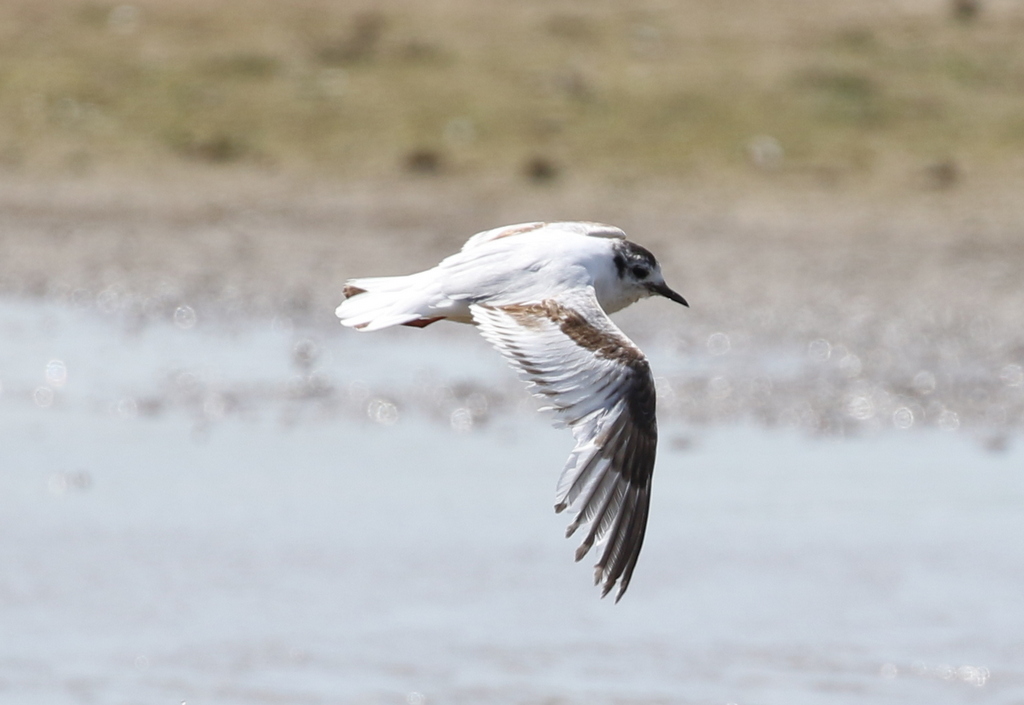
There were plenty of other gulls too – a small group of immature Common Gulls, a Lesser Black-backed Gull and a few Herring Gulls. A careful look through all the Black-headed Gulls in the fenced off island revealed several Mediterranean Gulls in with them. Through the scope, we could see their jet black hoods with contrasting white eyelids and brighter red bills, as well as their white wing tips.
Duck numbers are increasing again, as birds return from breeding attempts further north. The number of Teal is the most noticeable, and there was a little gang of them asleep on Tern Island, along with Shoveler, Gadwall and a Common Pochard. The ducks are all starting to moult into eclipse plumage too now, losing their smart breeding attire.
A single Brent Goose which appeared on the water behind Avocet Island was a bit of a surprise. There are lots here during the winter, but they should all be up in Russia now. The first returning Brent Geese don’t normally reach here until August, so perhaps this one has decided to stay here all summer. Two Pink-footed Geese swimming over the back of the Freshmarsh and injured birds, probably shot, which are unable to make the journey back to Iceland to breed.
There were lots more Avocets on the islands on this side, mostly asleep in a big mob. Once again, there were no juveniles amongst them, although a few looked like they might still be incubating and other pairs were mating or looking for a suitable nest site, presumably getting ready for a second attempt. When a Great Black-backed Gull flew over, all the Avocets woke up and flew round calling, after which several started to feed in front of the hide, sweeping their bills from side to side in the shallow water.
We had seen a Little Ringed Plover distantly from Island Hide, but when one flew in and landed on one of the islands just in front we got a much better look at it. We could see its bright golden yellow eye ring.
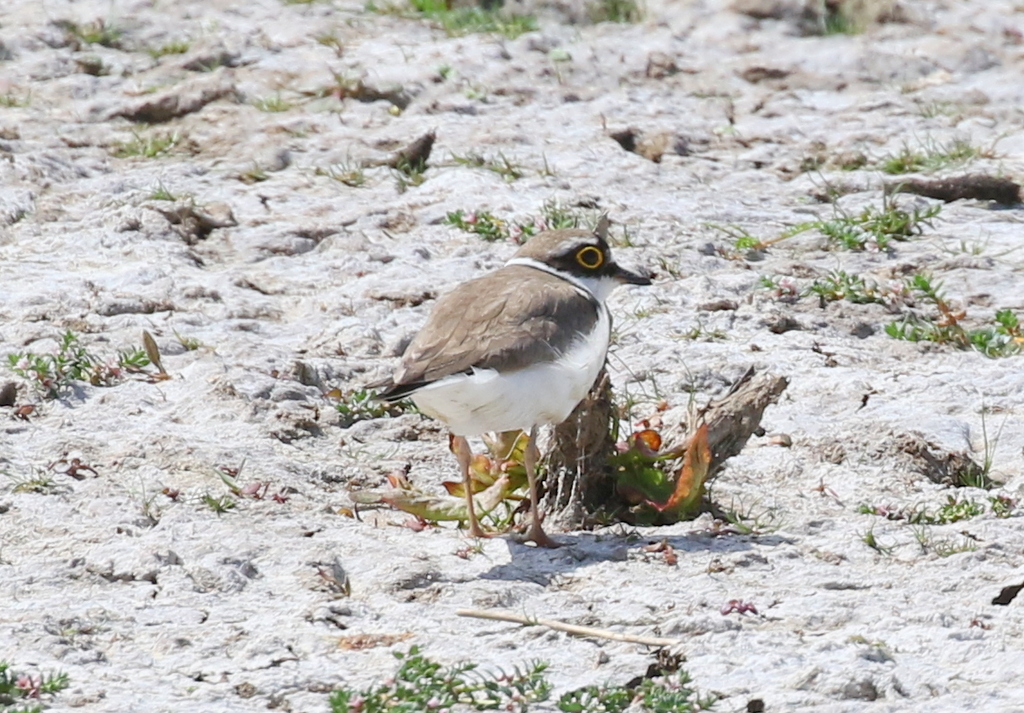
The Dunlin out on Tern Island seemed to have woken up and there were more of them now, so presumably some had returned. We could see a slightly larger bird in with them, lacking the Dunlin‘s black belly patch and with a longer and more strongly downcurved bill. It was the Curlew Sandpiper which had returned and was feeding in the water with the Dunlin now, so we had a good look at it through the scope.
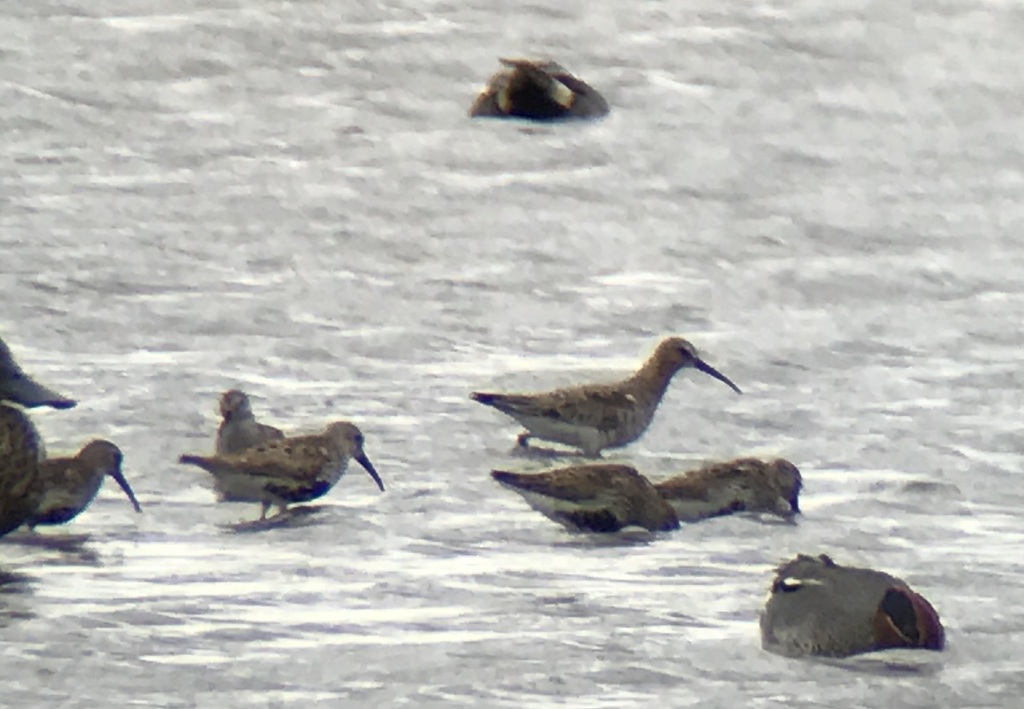
Despite the wind, we decided to make a quick pilgrimage out to the beach. There is not much on Volunteer Marsh at the moment, but a quick look over the wall did produce a Lapwing out on the mud, its iridescent plumage shining in the sun.

The tide was in when we got out to the sea, so there were no birds out on the beach. We had a quick look offshore, which produced two or three Sandwich Terns flying past, but little else today in the wind. We decided to head back.
A Reed Bunting had been singing out on the saltmarsh as we walked out, and was still at it as we returned. But now a second male Reed Bunting had appeared and was singing too, in response. This second bird’s favourite song bush happens to be right next to the path, so it regularly attracts a crowd of admirers. It was struggling to hold itself steady in the wind today, but still continued to sing.

Just past the dried up pool on Thornham grazing marsh, we heard Bearded Tits calling in the reeds. We thought we might get lucky and see one flying across but as we looked over the bank, we noticed a male Bearded Tit shuffling up a reed stem. Despite the wind, it stayed there for several seconds, allowing us to get a great look at it through our binoculars. We could see its powder blue-grey head and black moustache. It then flew towards us and landed in the reeds even closer, but didn’t stay long and then disappeared off round behind the bushes. What a bonus!
From there, we took a detour round via Meadow Trail and out to Patsy’s Reedbed. A Lesser Whitethroat was singing in the hedge as we passed, so we stopped to listen. In typical fashion, it stayed well hidden as it sang, but we did eventually see it briefly when it flew out and round the back of the hedge.
There were very few birds on Patsy’s Reedbed today, just a few wildfowl, a Tufted Duck, a family of Common Pochard and a Greylag. A Cetti’s Warbler shouted at us from somewhere in the bushes. The Marsh Harriers put on a good display over the reedbed beyond though. Two different females circled up over different areas of the reeds, before dropping back in.
Then a male Marsh Harrier appeared from the fields inland, flying in over Willow Wood. One of the females appeared out of the reeds and the two circled together before the male dropped its prey for the female to catch. The female disappeared back down into the reeds, while the male headed off inland again to resume hunting. Presumably it has growing young to feed.
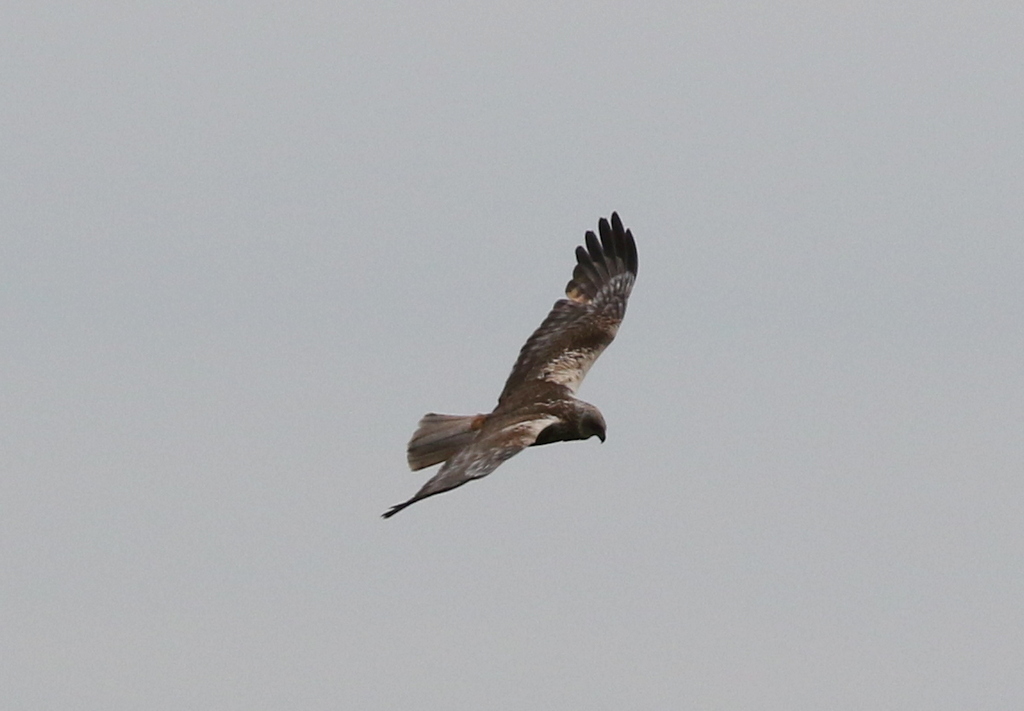
There has been a juvenile Tawny Owl roosting in the trees by the Visitor Centre in recent weeks and a few people were looking for it as we got back to the start of Fen Trail. We couldn’t see it at first, but eventually someone spotted it – there was only a very narrow window where you could see it through the leaves. We got it in the scope, a large ball of fluff just getting some adult feathers.
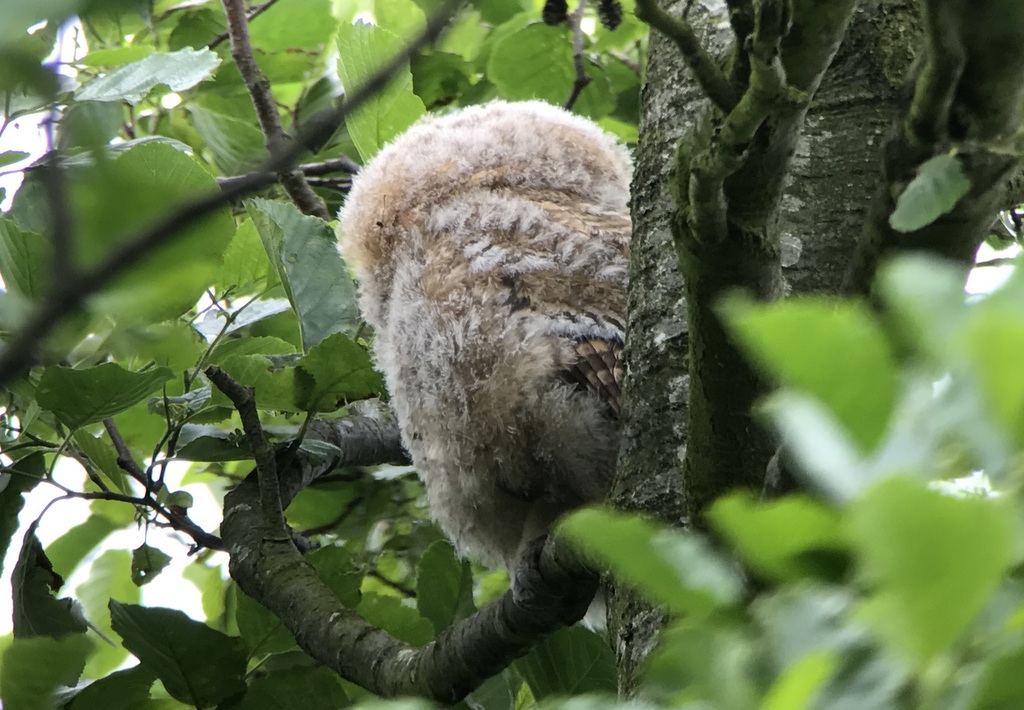
After lunch back in the picnic area, we headed off along the coast to Holme. It was very windy when we got out of the car by the paddocks and very blustery up on the coast path. We heard a couple of Common Whitethroats and a single Lesser Whitethroat singing from the bushes, but they were keeping well tucked down out of the wind today.
A Cuckoo was singing in the trees ahead of us, and we had a quick glimpse of it as it flew away, but it then taunted us by singing off in the distance on and off as we walked round. A pair of Linnets were more obliging, perching up in the bushes. The male Linnet was looking particularly smart now, with red breast and forehead spot.
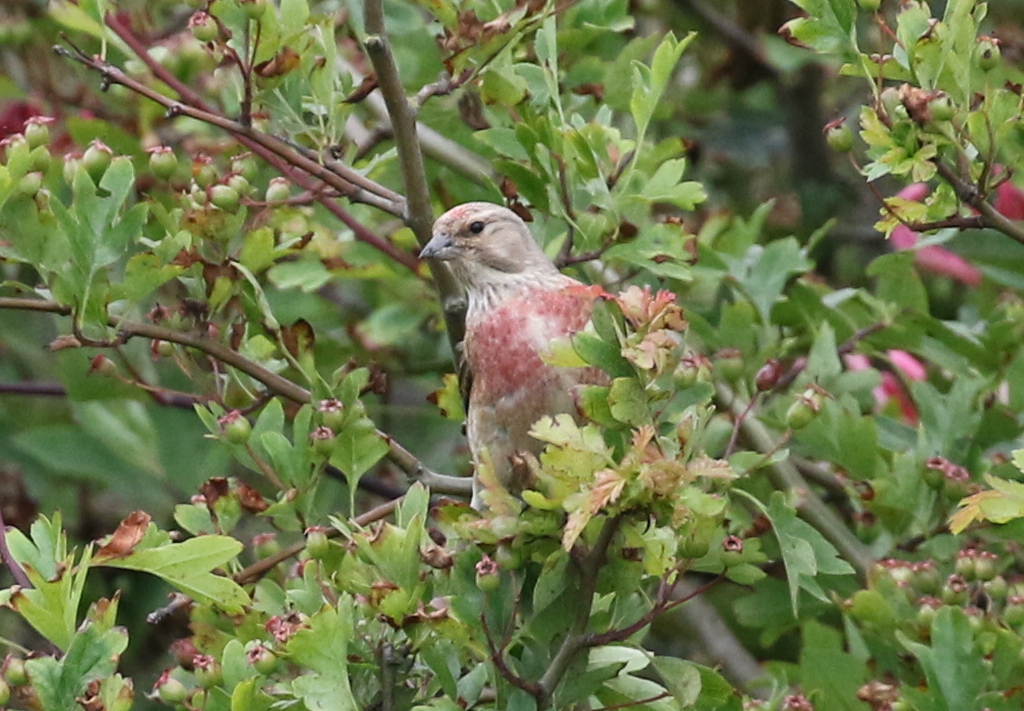
It was at this point that it started to spit with rain, so we took a detour across to the access road, and headed back to the car just in case. As it was, the clouds cleared through very quickly, before we got there. We headed back along the coast to Holkham for the remainder of the afternoon.
The wind had picked up even more when we got to Holkham, so we were happy to get into the shelter of the trees. An Egyptian Goose was the only bird of note on the new pools by the building site. A Lesser Whitethroat was singing in the hedge nearby, but there were not many other warblers singing now, as we made our way west.
A Jay appeared low down in an oak tree. There were a few flocks of tits in the trees – family groups of Long-tailed Tits that flicked through the vegetation calling, carrying a few Blue Tits or Great Tits with them already. We heard a Treecreeper singing and stopped to see if we could see it. First one flew across, and then a second, and we could still hear a third calling further back – it seemed like a family party.
The Treecreepers proved hard to see though, until one flew round from the back of the pine where it had been feeding and landed down on the needles right at the base of the trunk. It stretched out and spread its wings and appeared to be sunning itself. It stayed there, splayed out on the ground, for a couple of minutes before it finally took off and flew back into the trees. A couple of Coal Tits were feeding high in the pines above too.
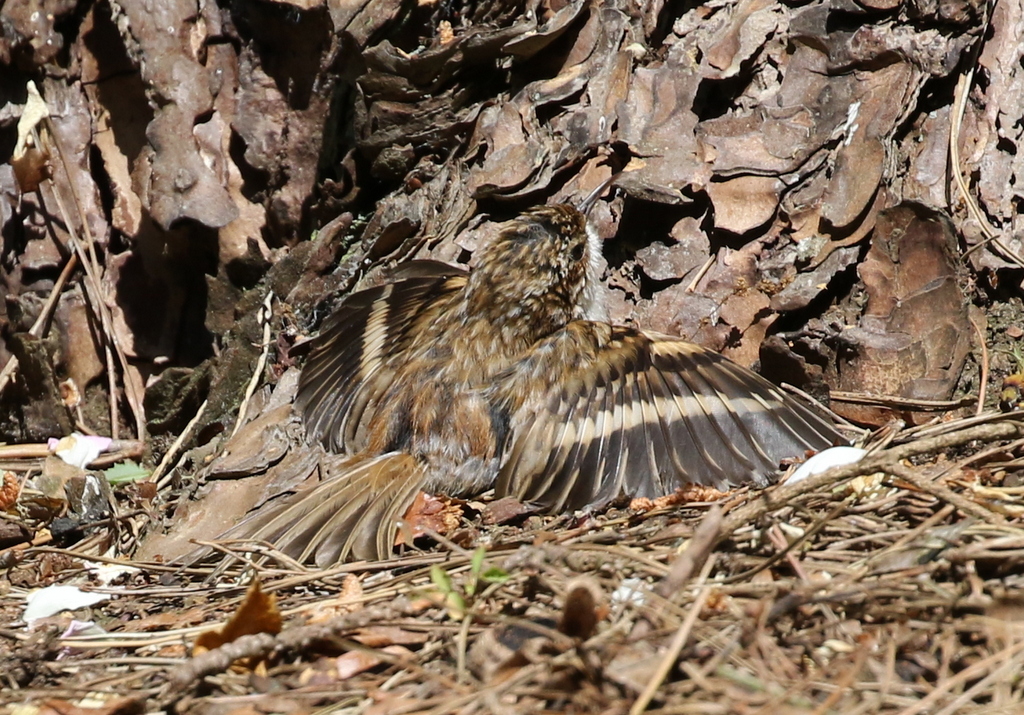
There was nothing on Salts Hole today, so we continued on to Washington Hide. We stood on the boardwalk for a few minutes while we watched a male Marsh Harrier hunting out on the grazing marshes. It dropped down into the grass and appeared to come up with something in its talons, but it was very small.
It couldn’t decide whether to stick or twist – it chased after a Meadow Pipit which flew up out of the grass. When the pipit escaped, the Marsh Harrier flew back in carrying the small morsel it had managed to catch and dropped down into the reeds with it.
The display of Foxgloves is looking very smart now in the pines, but as we walking through them towards Joe Jordan we saw all the Spoonbills taking off from the pool out on the grazing marshes. Something had spooked them and when we got up into the hide we could see what – one of the wardens was driving out to the colony to check up on the breeding birds.
Five of the Spoonbills disappeared straight off over the grazing marshes towards Burnham Overy. Several of the others circled high over the trees – at least we could get a look at them in flight, their necks outstretched, very different from the Little Egrets which were coming and going from the trees too. Just two Grey Herons were left out on the pool, and they were having a dispute over who was going to feed there.
We sat for a while and watched the comings and goings. There were lots of Cormorants on nests out in the trees and more flying back in from the sea. One or two Marsh Harriers flew in and out too and a Kestrel came up from the grass in front of the hide. A Common Buzzard circled up above the trees in the distance.
Finally, some of the Spoonbills plucked up the courage to return to the pool. First one flew down and landed on the edge of the water, followed quickly by another four. They were all recently fledged juveniles, still not quite fully grown and with much shorter bills than the adults – TeaSpoonbills!
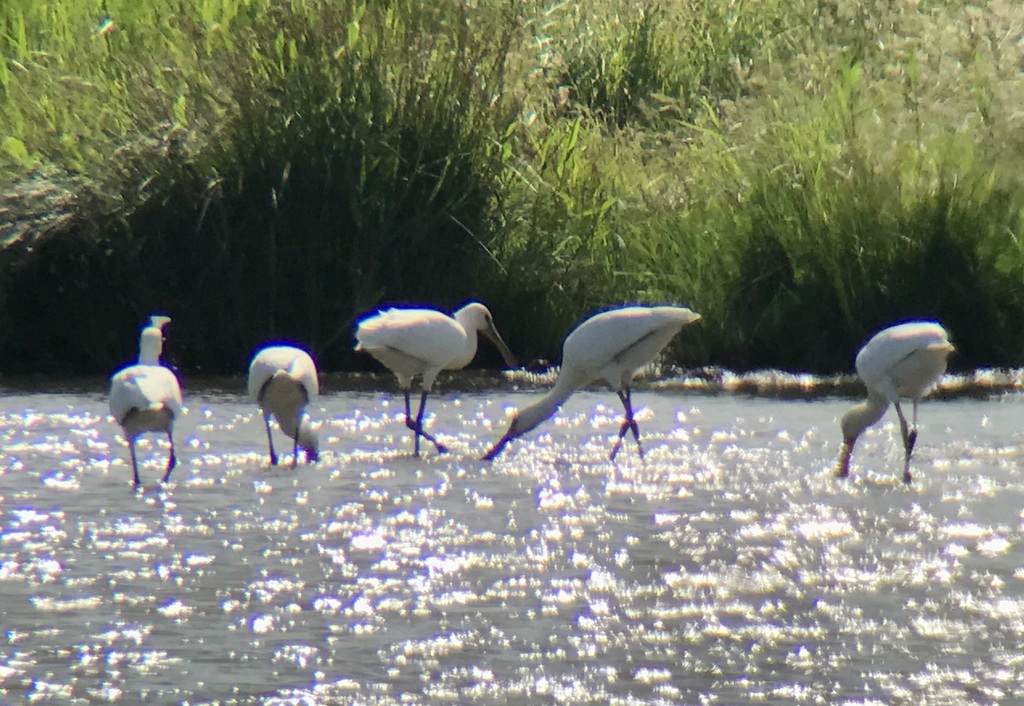
We had a look at the Spoonbills through the scope. They were practising feeding, sweeping their bills from side to side in the water as they walked round the edge of the pool. It was great to see some on the ground.
That was a fitting way to end the day, so we set off back to the car and then on home.
















